
10″ Std Housing 1/4 Inch Port
(N$ 250.70 VAT EX)
10″ Std Housing 1/4 Inch Port
10″ Standard Filter Housings are manufactured of durable polypropylene or clear Styrene-Acrylonitrile (SAN). These housings are available in 10″ lengths, while the caps are available with 1/4″ or 1/2″ NPT connections.
Opaque 10″ Standard filter housings, molded from rugged reinforced polypropylene, offer outstanding chemical compatibility and are ideal for use in a variety of low-flow applications. These applications include under sink and countertop residential filtration, pre- and post-reverse osmosis filtration, recreational vehicle filtration, food service, and humidifying systems.
Clear Flat Cap Slim Line housings offer on-site examination of flow, performance, and cartridge life. They are also ideal for a variety of applications.
FEATURES/BENEFITS
– Slim design reduces the space required for installation without sacrificing capacity
– Available in 10″ length
– Available in clear or opaque sumps
– Leak-proof seal
SPECIFICATIONS Of The 10″ Standard Filter Housings
Housing – Polypropylene (opaque) or Styrene Acrylonitrile (clear)
Cap – Reinforced Polypropylene
Button Assembly – 300 Series stainless steel, EPDM, and polypropylene
O-Ring – Buna-N
Temperature Rating – 40-125°F (4.4-51.7°C)
Maximum Pressure – 125 psi (8.6 bar)
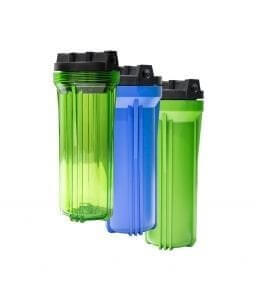
Jetsun Clearance HousingS
(N$ 172.50 VAT EX)
Jetsun Clearance Housings
10″ Standard Filter Housings are manufactured of durable polypropylene or clear Styrene-Acrylonitrile (SAN). These housings are available in 10″ lengths, while the caps are available with 1/4″ or 1/2″ NPT connections.
Opaque 10″ Standard filter housings, molded from rugged reinforced polypropylene, offer outstanding chemical compatibility and are ideal for use in a variety of low-flow applications. These applications include under sink and countertop residential filtration, pre- and post-reverse osmosis filtration, recreational vehicle filtration, food service, and humidifying systems.
Clear Flat Cap Slim Line housings offer on-site examination of flow, performance, and cartridge life. They are also ideal for a variety of applications.
FEATURES/BENEFITS
– Slim design reduces the space required for installation without sacrificing capacity
– Available in 10″ length
– Available in clear or opaque sumps
– Leak-proof seal
SPECIFICATIONS Of The 10″ Standard Filter Housings
Housing – Polypropylene (opaque) or Styrene Acrylonitrile (clear)
Cap – Reinforced Polypropylene
Button Assembly – 300 Series stainless steel, EPDM, and polypropylene
O-Ring – Buna-N
Temperature Rating – 40-125°F (4.4-51.7°C)
Maximum Pressure – 125 psi (8.6 bar)
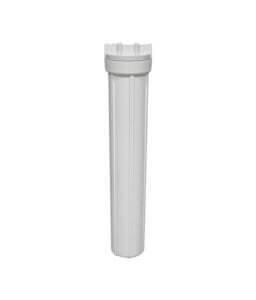
20″ Std Housing 3/4″ Port White
(N$ 457.70 VAT EX)
20″ Std Housing 3/4″ Port White
How does it work?
Water from the mains is connected to the inlet port of the Slimline Water Filter Housing unit. The water is directed downwards through the filter cartridge within the unit. This process removes unwanted contaminants, determined by the type of cartridge fitted inside the housing. The water then flows upwards through the center of the cartridge and through the outlet port, and supplies filtered water. Slim Line filter housings are available in either reinforced polypropylene. The reinforced polypropylene housing caps are available with 3/8″ NPT connections. Four bosses are molded into every cap for mounting purposes. Excellent for low-flow applications and when space and chemical compatibility are primary concerns.
– Slim design reduces space required for installation without sacrificing capacity
– FDA grade
– Pressure Release button/bleed button on the inlet side of the cap
– Leak-proof sealing with top-seated Buna-N O-ring
Slim Line Housings
Molded from rugged reinforced polypropylene, these housings are ideal for under-sink and countertop residential filtration, pre-and post-reverse osmosis filtration, recreational vehicle filtration, food service, humidifying systems, and light commercial and industrial filtration.
Materials of Construction
– Housing: Styrene Acrylonitrile (Clear) and Polypropylene (Opaque)
– Cap: Reinforced Polypropylene
– Button Assembly: 300-series Stainless Steel, Polypropylene, and EPDM
– O-Ring: Buna-N Maximum Temperature: 125°F (51.7°C) Maximum Pressure: 125 psi (8.62 bar)
– Maximum Dimensions: 21-7/8″ x 4-3/8″
– Initial Pressure (PSI) @ Flow Rate (GPM): 2 PSI @ 5 GPM
Product specifications:
– Filter housing color: blue
– Size: 20 Inch Slimline, i.e. 20 x 2.5 Inch
– O-Ring type: Single O-ring seal
– Inlet/Outlet port sizes: Female 1 Inch / 25mm thread
– Maximum pressure: 6 bar / 90psi
– Operating temperature range: 4 – 38°C
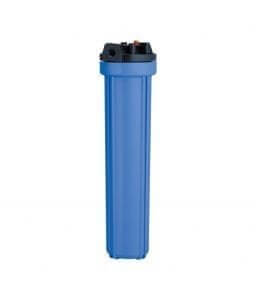
20″ Std Housing 3/4″ Port
(N$ 457.70 VAT EX)
20″ Std Housing 3/4″ Port White
How does it work?
Water from the mains is connected to the inlet port of the Slimline Water Filter Housing unit. The water is directed downwards through the filter cartridge within the unit. This process removes unwanted contaminants, determined by the type of cartridge fitted inside the housing. The water then flows upwards through the center of the cartridge and through the outlet port, and supplies filtered water.
Slim Line filter housings are available in either reinforced polypropylene. The reinforced polypropylene housing caps are available with 3/8″ NPT connections. Four bosses are molded into every cap for mounting purposes. Excellent for low-flow applications and when space and chemical compatibility are primary concerns.
– Slim design reduces space required for installation without sacrificing capacity
– FDA grade
– Pressure Release button/bleed button on the inlet side of the cap
– Leak-proof sealing with top-seated Buna-N O-ring
Slim Line Housings
Molded from rugged reinforced polypropylene, these housings are ideal for under-sink and countertop residential filtration, pre-and post-reverse osmosis filtration, recreational vehicle filtration, food service, humidifying systems, and light commercial and industrial filtration.
Materials of Construction
– Housing: Styrene Acrylonitrile (Clear) and Polypropylene (Opaque)
– Cap: Reinforced Polypropylene
– Button Assembly: 300-series Stainless Steel, Polypropylene, and EPDM
– O-Ring: Buna-N Maximum Temperature: 125°F (51.7°C) Maximum Pressure: 125 psi (8.62 bar)
– Maximum Dimensions: 21-7/8″ x 4-3/8″
– Initial Pressure (PSI) @ Flow Rate (GPM): 2 PSI @ 5 GPM
Product specifications:
– Filter housing color: blue
– Size: 20 Inch Slimline, i.e. 20 x 2.5 Inch
– O-Ring type: Single O-ring seal
– Inlet/Outlet port sizes: Female 1 Inch / 25mm thread
– Maximum pressure: 6 bar / 90psi
– Operating temperature range: 4 – 38°C

20″ Big Blue Water Filter Housing – Black Housing
(N$ 1 104.00 VAT EX)
20″ Big Blue Water Filter Housing – Black Housing
What Is A Big Blue Filter Housing?
20″ Big Blue and Big Black Heavy Duty Filter Housings offer the versatility to meet all of your large-capacity filtration needs, including high-flow and heavy-sediment applications. The extra-large housing allows for greater cartridge capacity, reducing the number of vessels required for high flow-rate applications. Sumps are available in 20″ lengths.
The High-Flow Polypropylene (HFPP) cap is available with 1″ NPT inlet and outlet ports. The 1 internal port allows a greater volume of liquid to pass through the HFPP cap more rapidly. Big Blue and Big Black Housings are compatible with a broad range of chemicals and are available with or without a pressure relief button. They accept a wide variety of 4-1/2″ diameter cartridges.
– Available in 20″ lengths.
– Available with a pressure relief button on the inlet side of the cap.
– Available with 1″ NPT inlet and outlet ports.
– Accepts up to 4-1/2″ diameter cartridges.
Specifications
– Temperature (Min): 4,444 °C
– Temperature (Max): 37,778 °C
– Pressure (Min): 40 psi
– Pressure (Max): 90 psi
How does a Big Blue water filter housing work?
A Big Blue filter housing holds big filter cartridges. Other manufacturers don’t describe their large diameter filter housings as Big Blue. Any term for large diameter housings refers to housings that operate the same way. Water enters one end and goes down through the housing. Depending on what type of filter cartridge you have, water might flow through the filter and then out, or it might go all the way to the bottom and flow up through the media in the drop-in cartridge. You can put a variety of filter cartridges inside a housing depending on what you’re trying to filter out.
How do you install a Big Blue filter housing?
The Big Blue housing cap inlet and outlet requires 1″ male fittings and depending on your plumbing pipe sizes, you may need to use a reducer to fit the pipe size. When you’re installing the filter and housing and you have an inch and a half plumbing, make sure the cap measures an inch and a half because you never want to reduce the size from your plumbing size.
If you’re using your Big Blue housing commercially, just connect the water into it. The cap has an in and an out. The IN is the feed side. The OUT is the filtered side. Make sure the in and out are lined up properly since the filter housing doesn’t come on a mounting bracket. Then install your mounting bracket on to hand the filter housing on the wall.
How often should you change a Big Blue filter housing?
Every 10 years.
Big Blue filter housings are dependable and last a long time. The manufacturer suggests that you replace it every 10 years. If the housing’s been in place for 10 years, you probably should replace it. Every time you turn a faucet off while water is flowing through this filter housing, water hammering occurs. This means the inertia of the water flow stops with a force of energy. Many times water hammering causes the housing to move or flex. Eventually, the plastic could get tired of flexing and start to crack.
Housings with clear sumps (body) don’t flex like the blue ones or the white ones or the black ones. Clear filter housings use a different plastic blend that doesn’t flex as well, so it cracks and fails much sooner than the polypropylene colored ones. We recommend you change a clear filter housing at least every five years so that you don’t end up with a catastrophic failure where the housing cracks and water floods.
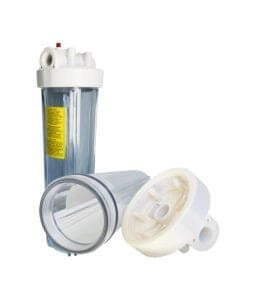
20″ Big Blue Water Filter Housing – Taiwan Clear Housing
(N$ 1 242.00 VAT EX)
20″ Big Blue Water Filter Housing – Taiwan Clear Housing
What Is A Big Blue Filter Housing?
20″ Big Blue and Big Black Heavy Duty Filter Housings offer the versatility to meet all of your large-capacity filtration needs, including high-flow and heavy-sediment applications. The extra-large housing allows for greater cartridge capacity, reducing the number of vessels required for high flow-rate applications. Sumps are available in 20″ lengths.
The High-Flow Polypropylene (HFPP) cap is available with 1″ NPT inlet and outlet ports. The 1 internal port allows a greater volume of liquid to pass through the HFPP cap more rapidly. Big Blue and Big Black Housings are compatible with a broad range of chemicals and are available with or without a pressure relief button. They accept a wide variety of 4-1/2″ diameter cartridges.
– Available in 20″ lengths.
– Available with a pressure relief button on the inlet side of the cap.
– Available with 1″ NPT inlet and outlet ports.
– Accepts up to 4-1/2″ diameter cartridges.
Specifications
– Temperature (Min): 4,444 °C
– Temperature (Max): 37,778 °C
– Pressure (Min): 40 psi
– Pressure (Max): 90 psi
How does a Big Blue water filter housing work?
A Big Blue filter housing holds big filter cartridges. Other manufacturers don’t describe their large diameter filter housings as Big Blue. Any term for large diameter housings refers to housings that operate the same way. Water enters one end and goes down through the housing. Depending on what type of filter cartridge you have, water might flow through the filter and then out, or it might go all the way to the bottom and flow up through the media in the drop-in cartridge. You can put a variety of filter cartridges inside a housing depending on what you’re trying to filter out.
How do you install a Big Blue filter housing?
The Big Blue housing cap inlet and outlet requires 1″ male fittings and depending on your plumbing pipe sizes, you may need to use a reducer to fit the pipe size. When you’re installing the filter and housing and you have an inch and a half plumbing, make sure the cap measures an inch and a half because you never want to reduce the size from your plumbing size.
If you’re using your Big Blue housing commercially, just connect the water into it. The cap has an in and an out. The IN is the feed side. The OUT is the filtered side. Make sure the in and out are lined up properly since the filter housing doesn’t come on a mounting bracket. Then install your mounting bracket on to hand the filter housing on the wall.
How often should you change a Big Blue filter housing?
Every 10 years.
Big Blue filter housings are dependable and last a long time. The manufacturer suggests that you replace it every 10 years. If the housing’s been in place for 10 years, you probably should replace it. Every time you turn a faucet off while water is flowing through this filter housing, water hammering occurs. This means the inertia of the water flow stops with a force of energy. Many times water hammering causes the housing to move or flex. Eventually, the plastic could get tired of flexing and start to crack.
Housings with clear sumps (body) don’t flex like the blue ones or the white ones or the black ones. Clear filter housings use a different plastic blend that doesn’t flex as well, so it cracks and fails much sooner than the polypropylene colored ones. We recommend you change a clear filter housing at least every five years so that you don’t end up with a catastrophic failure where the housing cracks and water floods.
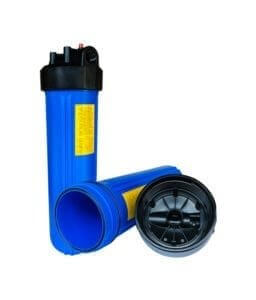
20″ Big Blue Water Filter Housing – Taiwan Double O Ring
(N$ 1 242.00 VAT EX)
20″ Big Blue Water Filter Housing – Taiwan Double O Ring
What Is A Big Blue Filter Housing?
20″ Big Blue and Big Black Heavy Duty Filter Housings offer the versatility to meet all of your large-capacity filtration needs, including high-flow and heavy-sediment applications. The extra-large housing allows for greater cartridge capacity, reducing the number of vessels required for high flow-rate applications. Sumps are available in 20″ lengths.
The High-Flow Polypropylene (HFPP) cap is available with 1″ NPT inlet and outlet ports. The 1 internal port allows a greater volume of liquid to pass through the HFPP cap more rapidly. Big Blue and Big Black Housings are compatible with a broad range of chemicals and are available with or without a pressure relief button. They accept a wide variety of 4-1/2″ diameter cartridges.
– Available in 20″ lengths.
– Available with a pressure relief button on the inlet side of the cap.
– Available with 1″ NPT inlet and outlet ports.
– Accepts up to 4-1/2″ diameter cartridges.
Specifications
– Temperature (Min): 4,444 °C
– Temperature (Max): 37,778 °C
– Pressure (Min): 40 psi
– Pressure (Max): 90 psi
How does a Big Blue water filter housing work?
A Big Blue filter housing holds big filter cartridges. Other manufacturers don’t describe their large diameter filter housings as Big Blue. Any term for large diameter housings refers to housings that operate the same way. Water enters one end and goes down through the housing. Depending on what type of filter cartridge you have, water might flow through the filter and then out, or it might go all the way to the bottom and flow up through the media in the drop-in cartridge. You can put a variety of filter cartridges inside a housing depending on what you’re trying to filter out.
How do you install a Big Blue filter housing?
The Big Blue housing cap inlet and outlet requires 1″ male fittings and depending on your plumbing pipe sizes, you may need to use a reducer to fit the pipe size. When you’re installing the filter and housing and you have an inch and a half plumbing, make sure the cap measures an inch and a half because you never want to reduce the size from your plumbing size.
If you’re using your Big Blue housing commercially, just connect the water into it. The cap has an in and an out. The IN is the feed side. The OUT is the filtered side. Make sure the in and out are lined up properly since the filter housing doesn’t come on a mounting bracket. Then install your mounting bracket on to hand the filter housing on the wall.
How often should you change a Big Blue filter housing?
Every 10 years.
Big Blue filter housings are dependable and last a long time. The manufacturer suggests that you replace it every 10 years. If the housing’s been in place for 10 years, you probably should replace it. Every time you turn a faucet off while water is flowing through this filter housing, water hammering occurs. This means the inertia of the water flow stops with a force of energy. Many times water hammering causes the housing to move or flex. Eventually, the plastic could get tired of flexing and start to crack.
Housings with clear sumps (body) don’t flex like the blue ones or the white ones or the black ones. Clear filter housings use a different plastic blend that doesn’t flex as well, so it cracks and fails much sooner than the polypropylene colored ones. We recommend you change a clear filter housing at least every five years so that you don’t end up with a catastrophic failure where the housing cracks and water floods.
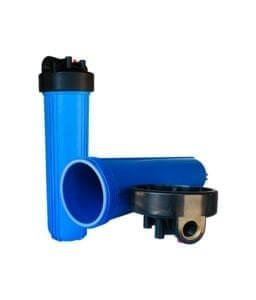
20″ Big Blue Water Filter Housing – Brass Port White O Ring
(N$ 966.00 VAT EX)
20″ Big Blue Water Filter Housing – Brass Port White O Ring
What Is A Big Blue Filter Housing?
20″ Big Blue and Big Black Heavy Duty Filter Housings offer the versatility to meet all of your large-capacity filtration needs, including high-flow and heavy-sediment applications. The extra-large housing allows for greater cartridge capacity, reducing the number of vessels required for high flow-rate applications. Sumps are available in 20″ lengths.
The High-Flow Polypropylene (HFPP) cap is available with 1″ NPT inlet and outlet ports. The 1 internal port allows a greater volume of liquid to pass through the HFPP cap more rapidly. Big Blue and Big Black Housings are compatible with a broad range of chemicals and are available with or without a pressure relief button. They accept a wide variety of 4-1/2″ diameter cartridges.
– Available in 20″ lengths.
– Available with a pressure relief button on the inlet side of the cap.
– Available with 1″ NPT inlet and outlet ports.
– Accepts up to 4-1/2″ diameter cartridges.
Specifications
– Temperature (Min): 4,444 °C
– Temperature (Max): 37,778 °C
– Pressure (Min): 40 psi
– Pressure (Max): 90 psi
How does a Big Blue water filter housing work?
A Big Blue filter housing holds big filter cartridges. Other manufacturers don’t describe their large diameter filter housings as Big Blue. Any term for large diameter housings refers to housings that operate the same way. Water enters one end and goes down through the housing. Depending on what type of filter cartridge you have, water might flow through the filter and then out, or it might go all the way to the bottom and flow up through the media in the drop-in cartridge. You can put a variety of filter cartridges inside a housing depending on what you’re trying to filter out.
How do you install a Big Blue filter housing?
The Big Blue housing cap inlet and outlet requires 1″ male fittings and depending on your plumbing pipe sizes, you may need to use a reducer to fit the pipe size. When you’re installing the filter and housing and you have an inch and a half plumbing, make sure the cap measures an inch and a half because you never want to reduce the size from your plumbing size.
If you’re using your Big Blue housing commercially, just connect the water into it. The cap has an in and an out. The IN is the feed side. The OUT is the filtered side. Make sure the in and out are lined up properly since the filter housing doesn’t come on a mounting bracket. Then install your mounting bracket on to hand the filter housing on the wall.
How often should you change a Big Blue filter housing?
Every 10 years.
Big Blue filter housings are dependable and last a long time. The manufacturer suggests that you replace it every 10 years. If the housing’s been in place for 10 years, you probably should replace it. Every time you turn a faucet off while water is flowing through this filter housing, water hammering occurs. This means the inertia of the water flow stops with a force of energy. Many times water hammering causes the housing to move or flex. Eventually, the plastic could get tired of flexing and start to crack.
Housings with clear sumps (body) don’t flex like the blue ones or the white ones or the black ones. Clear filter housings use a different plastic blend that doesn’t flex as well, so it cracks and fails much sooner than the polypropylene colored ones. We recommend you change a clear filter housing at least every five years so that you don’t end up with a catastrophic failure where the housing cracks and water floods.
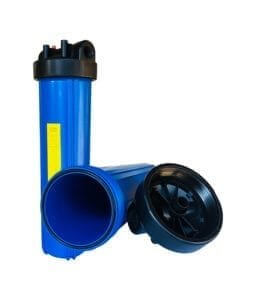
20″ Big Blue Water Filter Housing – Single O RinG
(N$ 966.00 VAT EX)
20″ Big Blue Water Filter Housing – Single O Ring
What Is A Big Blue Filter Housing?
20″ Big Blue and Big Black Heavy Duty Filter Housings offer the versatility to meet all of your large-capacity filtration needs, including high-flow and heavy-sediment applications. The extra-large housing allows for greater cartridge capacity, reducing the number of vessels required for high flow-rate applications. Sumps are available in 20″ lengths.
The High-Flow Polypropylene (HFPP) cap is available with 1″ NPT inlet and outlet ports. The 1 internal port allows a greater volume of liquid to pass through the HFPP cap more rapidly. Big Blue and Big Black Housings are compatible with a broad range of chemicals and are available with or without a pressure relief button. They accept a wide variety of 4-1/2″ diameter cartridges.
– Available in 20″ lengths.
– Available with a pressure relief button on the inlet side of the cap.
– Available with 1″ NPT inlet and outlet ports.
– Accepts up to 4-1/2″ diameter cartridges.
Specifications
– Temperature (Min): 4,444 °C
– Temperature (Max): 37,778 °C
– Pressure (Min): 40 psi
– Pressure (Max): 90 psi
How does a Big Blue water filter housing work?
A Big Blue filter housing holds big filter cartridges. Other manufacturers don’t describe their large diameter filter housings as Big Blue. Any term for large diameter housings refers to housings that operate the same way. Water enters one end and goes down through the housing. Depending on what type of filter cartridge you have, water might flow through the filter and then out, or it might go all the way to the bottom and flow up through the media in the drop-in cartridge. You can put a variety of filter cartridges inside a housing depending on what you’re trying to filter out.
How do you install a Big Blue filter housing?
The Big Blue housing cap inlet and outlet requires 1″ male fittings and depending on your plumbing pipe sizes, you may need to use a reducer to fit the pipe size. When you’re installing the filter and housing and you have an inch and a half plumbing, make sure the cap measures an inch and a half because you never want to reduce the size from your plumbing size.
If you’re using your Big Blue housing commercially, just connect the water into it. The cap has an in and an out. The IN is the feed side. The OUT is the filtered side. Make sure the in and out are lined up properly since the filter housing doesn’t come on a mounting bracket. Then install your mounting bracket on to hand the filter housing on the wall.
How often should you change a Big Blue filter housing?
Every 10 years.
Big Blue filter housings are dependable and last a long time. The manufacturer suggests that you replace it every 10 years. If the housing’s been in place for 10 years, you probably should replace it. Every time you turn a faucet off while water is flowing through this filter housing, water hammering occurs. This means the inertia of the water flow stops with a force of energy. Many times water hammering causes the housing to move or flex. Eventually, the plastic could get tired of flexing and start to crack.
Housings with clear sumps (body) don’t flex like the blue ones or the white ones or the black ones. Clear filter housings use a different plastic blend that doesn’t flex as well, so it cracks and fails much sooner than the polypropylene colored ones. We recommend you change a clear filter housing at least every five years so that you don’t end up with a catastrophic failure where the housing cracks and water floods.

Bag Filter Housing – D/Length
(N$ 11 500.00 VAT EX)
Bag Filter Housing – D/Length
DESCRIPTION
Bag filter housing also named filter vessel, including single filter housing and multi-bag filter housing. It offers a wide range of filter housing designs with high flow capacities and contaminant holding capabilities, such as stainless steel filter housing, #2 filter housing, liquid filter housing, bag filters for water treatment.
The filter housing is mirror polished to resist adhesion of dirt and scale. Rapid opening and closing lids ensure simple operation with minimally used filter housing downtime for filter bags change-out. Side inlet and bottom outlet of stainless steel filter housing provide easy and complete drainage.
As a leading sock filter housing & bag filter housing manufacturer in global, standard filter housings handle flows up to 6,000 GPM. If that’s not big enough, we can custom filter housing sizes with various filter bags to meet your needs. The stainless steel filter housings also offer some special options: Different Outlet Connections, Higher Pressure Ratings, Extra- Length Legs, High Flow Rates, Special Materials…
Features
– Material: carbon, SS304, SS316, SS316L
– Swing bolt closure allows for quick bag change out
– Work pressure up to 1.5 Mpa with 250°F
– Surface treatment: mirror polishing
– Filtration precision: 0.5um-200um
– Configurations: side-in/side-out and side-in/bottom-out
– Housing volume is optimized to minimize product loss.
– High temperature & High-pressure design are available.
– Quick access bag replacement
– High flow rates with a low-pressure drop
– Positive O-ring sealing offers easy and safe operation.
– Optional 134 epoxy coating for seawater/corrosive applications
– Special requests: duplex type, adjustable-height legs, mounted on pedestal…
Applications Of A Bag Filter Housing
– Food and beverage industry
– Municipal & Industrial water treatment
– Petrochemical industry
– Oil and gas industry
– Paints, inks, resins, and coatings
– Textile, printing, paper making industry
– Edible oils and soap industry
– Pharmaceutical industry
– Electronic and electroplating industry
– Machining industry
– Other liquid filtration

Bag Filter Housing – S/Length
(N$ 9 200.00 VAT EX)
Bag Filter Housing – S/Length
DESCRIPTION
Bag filter housing also named filter vessel, including single filter housing and multi-bag filter housing. It offers a wide range of filter housing designs with high flow capacities and contaminant holding capabilities, such as stainless steel filter housing, #2 filter housing, liquid filter housing, bag filters for water treatment.
The filter housing is mirror polished to resist adhesion of dirt and scale. Rapid opening and closing lids ensure simple operation with minimally used filter housing downtime for filter bags change-out. Side inlet and bottom outlet of stainless steel filter housing provide easy and complete drainage.
As a leading sock filter housing & bag filter housing manufacturer in global, standard filter housings handle flows up to 6,000 GPM. If that’s not big enough, we can custom filter housing sizes with various filter bags to meet your needs. The stainless steel filter housings also offer some special options: Different Outlet Connections, Higher Pressure Ratings, Extra- Length Legs, High Flow Rates, Special Materials…
Features
– Material: carbon, SS304, SS316, SS316L
– Swing bolt closure allows for quick bag change out
– Work pressure up to 1.5 Mpa with 250°F
– Surface treatment: mirror polishing
– Filtration precision: 0.5um-200um
– Configurations: side-in/side-out and side-in/bottom-out
– Housing volume is optimized to minimize product loss.
– High temperature & High-pressure design are available.
– Quick access bag replacement
– High flow rates with a low-pressure drop
– Positive O-ring sealing offers easy and safe operation.
– Optional 134 epoxy coating for seawater/corrosive applications
– Special requests: duplex type, adjustable-height legs, mounted on pedestal…
Applications Of A Bag Filter Housing
– Food and beverage industry
– Municipal & Industrial water treatment
– Petrochemical industry
– Oil and gas industry
– Paints, inks, resins, and coatings
– Textile, printing, paper making industry
– Edible oils and soap industry
– Pharmaceutical industry
– Electronic and electroplating industry
– Machining industry
– Other liquid filtration
When looking for a cost-effective single-bag filter vessel that is both durable and reliable, look to the Puritech series vessels. You can still realize the benefits of an economic filter vessel that is manufactured to the same high standards and engineering expertise that characterizes all of our other FSI vessels.
Value-Added Features
– Side inlet piping connections
– Sizes for #01 single or #02 double-length filter bags
– Stainless steel basket 2″
– NPT threaded piping connections
– Maximum operating pressure of 100 psi
– The maximum operating temperature of 200F
– Concave cover with V-clamp closure
– Type 304 stainless steel construction
Available Options
– Adjustable mounting legs
High-quality, economical filter housings for cost-sensitive applications up to 100 psi. For cost-sensitive applications, you can now take advantage of a stainless steel vessel from Puritech at a price that compares to carbon steel. Even if your application may not now require stainless steel, you can still take advantage of the superior corrosion resistance and consistent performance you’ll get over the years. Should your process parameters change in the future, you’ll avoid the cost and hassle of an expensive upgrade from carbon steel. The Filter Bag Housing saves operating costs, too, with its simple, easy to operate V-clamp closure that makes bag changeouts quick and easy.
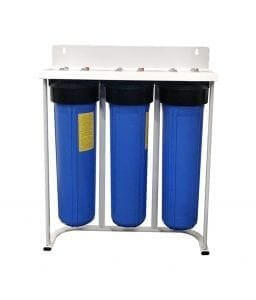
Whole House System – Dawn Namibia
(N$ 3 450.00 VAT EX)
Whole House System Dawn Namibia
DESCRIPTION
Triple Stage Whole House System
The Whole House System is designed with a three-stage water filtration system that consists of Polypropylene Sediment Removal filters and A Activated Carbon Block filter, and an ultraviolet disinfection system.
The following are the filtration stages of a Whole House System
First & Third Stage Filtration (Polypropylene Sediment removal Filters)
This sediment filter is for domestic water filtration purposes. It is designed to filter out sediments such as rust, mud, and dust particles from the municipality and rainwater.
The polypropylene sediment removal filter cartridge is constructed by three layers three of heat melting polypropylene. Compared to monolayer, the application life of PP melt blown filter cartridge with three layers is much longer. Therefore, the maintenance of the filters can be cut down a lot Using the right heating way for PP fiber, it can reduce the filtering resistance a lot and enlarge the water flow much The uniform space of fiber can achieve an excellent filtering effect As the filter cartridge is only made from polypropylene, the resistance to chemical reagents for both organic solvent and the inorganic solvent is all good.
Most water purifiers use a polypropylene sediment removal filter cartridge for the first stage of the filter element. The first stage of the filter element is not only directly affects the water quality but also affects the subsequent secondary or tertiary filtration effect and the life of the filter element. Therefore, the quality of PP filter is especially important for water purifiers.
If the RO system is not equipped with a polypropylene sediment removal filter, the raw water directly enters the RO membrane. Excessive particles, precipitates, microorganisms, and bacterial viruses that are not treated will block in the RO membrane, and the life of the RO membrane will be shortened, which will also affect the quality of the final water.
FUNCTION:
The function of the polypropylene sediment removal filter cartridge filter is to separate substances or particles from the liquid. The cartridge filter is a medium to filtrate substance that flows with liquid. Cartridge filter in this project focuses on a water filtration system that usually used at houses and small-scale industries. The volume flow rate relates to the pressure of the water that flows through the pipe system. Cartridge filter function as a media that reduced pressure from the water flow and call pressure drop. Sediment sand particles function as particles that flow with the water and will filtrate with a cartridge filter. Sediment sand makes contact on the surface of the cartridge filter depend on the volume flow rate of water.
The cartridge will be clogged because of sediment sand clog on the surface of the cartridge filter when tried to enter the cartridge filter. This situation makes the filtration system has different pressure on the entrance and the exit of the cartridge housing. Different pressure call pressure drop represents the pressure drop of the cartridge. The pressure drop can relate to the volume flow rate and determining the life span and maximum condition of the cartridge filter. The maximum clogging condition happens because the pressure of the cartridge filter does not increase anymore and the cartridge filter has fully clogged with sediment sand.
Second Stage Filtration (Activated Carbon Block Filter)
CTO Carbon block filters are made from activated carbon and its specific function is the chemical adsorption of impurities and contaminants in drinking water.
Activated carbon block filter is an ideal medium for treating contaminants in water, offering a large surface area for the adsorption of dissolved matter. Building upon this, the solid carbon block enhances the medium by preventing channeling, increasing surface contact time, and enabling custom pore formulation for mechanical filtration. Carbon Blocks are one of the most effective and widely used technologies in the Point Of Use (POU) drinking water treatment industry.
This comprehensive guide addresses key considerations a buyer should evaluate when designing a carbon block filter and selecting a supplier, including:
– Activated Carbon for Water Filtration
– Why Carbon Block is the Better Choice
– How Carbon Blocks Filter Water
– Compressed vs. Extruded Carbon Block Manufacturing Processes
– Carbon Block vs. Other Filtration Technologies
– Design Parameters
– Performance Indication Device
– Advantages of a Custom Filter
– Choosing a Custom Carbon Block Supplier
– Your Custom Carbon Block Specifications
Function Of An Activated Carbon Block Filter Cartridge:
Carbon block filters are made from activated carbon. Its function is to adsorb chemical impurities and contaminants in drinking water. Carbon filters are widely used to remove chlorine, taste, odor, and color.

Whole House System – Aqua Heart
(N$ 3 450.00 VAT EX)
Whole House System Dawn Namibia
DESCRIPTION
Triple Stage Whole House System
The Whole House System is designed with a three-stage water filtration system that consists of Polypropylene Sediment Removal filters and A Activated Carbon Block filter, and an ultraviolet disinfection system.
The following are the filtration stages of a Whole House System
First & Third Stage Filtration (Polypropylene Sediment removal Filters)
This sediment filter is for domestic water filtration purposes. It is designed to filter out sediments such as rust, mud, and dust particles from the municipality and rainwater.
The polypropylene sediment removal filter cartridge is constructed by three layers three of heat melting polypropylene. Compared to monolayer, the application life of PP melt blown filter cartridge with three layers is much longer. Therefore, the maintenance of the filters can be cut down a lot Using the right heating way for PP fiber, it can reduce the filtering resistance a lot and enlarge the water flow much The uniform space of fiber can achieve an excellent filtering effect As the filter cartridge is only made from polypropylene, the resistance to chemical reagents for both organic solvent and the inorganic solvent is all good.
Most water purifiers use a polypropylene sediment removal filter cartridge for the first stage of the filter element. The first stage of the filter element is not only directly affects the water quality but also affects the subsequent secondary or tertiary filtration effect and the life of the filter element. Therefore, the quality of PP filter is especially important for water purifiers.
If the RO system is not equipped with a polypropylene sediment removal filter, the raw water directly enters the RO membrane. Excessive particles, precipitates, microorganisms, and bacterial viruses that are not treated will block in the RO membrane, and the life of the RO membrane will be shortened, which will also affect the quality of the final water.
FUNCTION:
The function of the polypropylene sediment removal filter cartridge filter is to separate substances or particles from the liquid. The cartridge filter is a medium to filtrate substance that flows with liquid. Cartridge filter in this project focuses on a water filtration system that usually used at houses and small-scale industries. The volume flow rate relates to the pressure of the water that flows through the pipe system. Cartridge filter function as a media that reduced pressure from the water flow and call pressure drop. Sediment sand particles function as particles that flow with the water and will filtrate with a cartridge filter. Sediment sand makes contact on the surface of the cartridge filter depend on the volume flow rate of water.
The cartridge will be clogged because of sediment sand clog on the surface of the cartridge filter when tried to enter the cartridge filter. This situation makes the filtration system has different pressure on the entrance and the exit of the cartridge housing. Different pressure call pressure drop represents the pressure drop of the cartridge. The pressure drop can relate to the volume flow rate and determining the life span and maximum condition of the cartridge filter. The maximum clogging condition happens because the pressure of the cartridge filter does not increase anymore and the cartridge filter has fully clogged with sediment sand.
Second Stage Filtration (Activated Carbon Block Filter)
CTO Carbon block filters are made from activated carbon and its specific function is the chemical adsorption of impurities and contaminants in drinking water.
Activated carbon block filter is an ideal medium for treating contaminants in water, offering a large surface area for the adsorption of dissolved matter. Building upon this, the solid carbon block enhances the medium by preventing channeling, increasing surface contact time, and enabling custom pore formulation for mechanical filtration. Carbon Blocks are one of the most effective and widely used technologies in the Point Of Use (POU) drinking water treatment industry.
This comprehensive guide addresses key considerations a buyer should evaluate when designing a carbon block filter and selecting a supplier, including:
– Activated Carbon for Water Filtration
– Why Carbon Block is the Better Choice
– How Carbon Blocks Filter Water
– Compressed vs. Extruded Carbon Block Manufacturing Processes
– Carbon Block vs. Other Filtration Technologies
– Design Parameters
– Performance Indication Device
– Advantages of a Custom Filter
– Choosing a Custom Carbon Block Supplier
– Your Custom Carbon Block Specifications
Function Of An Activated Carbon Block Filter Cartridge:
Carbon block filters are made from activated carbon. Its function is to adsorb chemical impurities and contaminants in drinking water. Carbon filters are widely used to remove chlorine, taste, odor, and color.
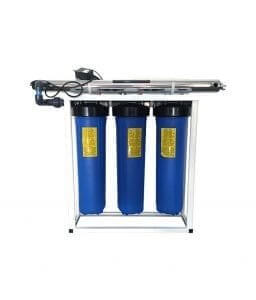
Whole House System + UV
(N$ 10 348.28 VAT EX)
Whole House System +UV
DESCRIPTION
WHOLE HOUSE WATER FILTRATION SYSTEM WITH AN ULTRAVIOLET DISINFECTION SYSTEM
The Whole House Water Filtration System is designed with a three-stage water filtration system that consists of 2x 20″ 1 and 5 microns Big Blue Polypropylene Sediment Removal filters, 1x 20″ Big Blue Activated Carbon Block filter, and ultraviolet disinfection system.
First & Third Stage Filtration (Polypropylene Sediment removal Filters)
This sediment filter is for domestic water filtration purposes. It is designed to filter out sediments such as rust, mud, and dust particles from the municipality and rainwater.
The polypropylene sediment removal filter cartridge is constructed by three layers three of heat melting polypropylene. Compared to monolayer, the application life of PP melt blown filter cartridge with three layers is much longer. Therefore, the maintenance of the filters can be cut down a lot Using the right heating way for PP fiber, can reduce the filtering resistance a lot and enlarge the water flow much The uniform space of fiber can achieve an excellent filtering effect As the filter cartridge is only made from polypropylene, the resistance to chemical reagents for both organic solvent and the inorganic solvent is all good.
Most water purifiers use a polypropylene sediment removal filter cartridge for the first stage of the filter element. The first stage of the filter element is not only directly affects the water quality but also affects the subsequent secondary or tertiary filtration effect and the life of the filter element. Therefore, the quality of the PP filter is especially important for water purifiers. If the RO system is not equipped with a polypropylene sediment removal filter, the raw water directly enters the RO membrane. Excessive particles, precipitates, microorganisms, and bacterial viruses that are not treated will block in the RO membrane, and the life of the RO membrane will be shortened, which will also affect the quality of the final water.
Most water purifiers use a polypropylene sediment removal filter cartridge for the first stage of the filter element. The first stage of the filter element is not only directly affects the water quality but also affects the subsequent secondary or tertiary filtration effect and the life of the filter element. Therefore, the quality of PP filter is especially important for water purifiers.
If the RO system is not equipped with a polypropylene sediment removal filter, the raw water directly enters the RO membrane. Excessive particles, precipitates, microorganisms, and bacterial viruses that are not treated will block in the RO membrane, and the life of the RO membrane will be shortened, which will also affect the quality of the final water.
FUNCTION:
The function of the polypropylene sediment removal filter cartridge filter is to separate substances or particles from the liquid. The cartridge filter is a medium to filtrate substance that flows with liquid. Cartridge filter in this project focuses on a water filtration system that usually used at houses and small-scale industries. The volume flow rate relates to the pressure of the water that flows through the pipe system. Cartridge filter function as a media that reduced pressure from the water flow and call pressure drop. Sediment sand particles function as particles that flow with the water and will filtrate with a cartridge filter. Sediment sand makes contact on the surface of the cartridge filter depend on the volume flow rate of water.
The cartridge will be clogged because of sediment sand clog on the surface of the cartridge filter when tried to enter the cartridge filter. This situation makes the filtration system has different pressure on the entrance and the exit of the cartridge housing. Different pressure call pressure drop represents the pressure drop of the cartridge. The pressure drop can relate to the volume flow rate and determining the life span and maximum condition of the cartridge filter. The maximum clogging condition happens because the pressure of the cartridge filter does not increase anymore and the cartridge filter has fully clogged with sediment sand.
Second Stage Filtration (Activated Carbon Block Filter)
CTO Carbon block filters are made from activated carbon and its specific function is the chemical adsorption of impurities and contaminants in drinking water.
Activated carbon block filter is an ideal medium for treating contaminants in water, offering a large surface area for the adsorption of dissolved matter. Building upon this, the solid carbon block enhances the medium by preventing channeling, increasing surface contact time, and enabling custom pore formulation for mechanical filtration. Carbon Blocks are one of the most effective and widely used technologies in the Point Of Use (POU) drinking water treatment industry.
This comprehensive guide addresses key considerations a buyer should evaluate when designing a carbon block filter and selecting a supplier, including:
– Activated Carbon for Water Filtration
– Why Carbon Block is the Better Choice
– How Carbon Blocks Filter Water
– Compressed vs. Extruded Carbon Block Manufacturing Processes
– Carbon Block vs. Other Filtration Technologies
– Design Parameters
– Performance Indication Device
– Advantages of a Custom Filter
– Choosing a Custom Carbon Block Supplier
– Your Custom Carbon Block Specifications
Function Of An Activated Carbon Block Filter Cartridge:
Carbon block filters are made from activated carbon. Its function is to adsorb chemical impurities and contaminants in drinking water. Carbon filters are widely used to remove chlorine, taste, odor, and color.
Last Stage Disinfection (Ultraviolet System)
WHAT IS A UV STERILIZER?
Ultraviolet or UV water sterilizer are used in water purification and treatment to make water healthier and prolong the life of water that has been treated and processed. The word “sterile” is defined as being free from living germs or microorganisms. An Ultraviolet sterilizer extraordinarily cleans water and kills bacteria and microorganisms that can be able to infest water even after it has been treated.
UV is a type of energy found in the electromagnetic spectrum, lying between x-rays and visible light. Although we cannot see Ultraviolet light or rays, we are exposed to them every time we step out into the sun. In fact, Ultraviolet light is responsible for causing sunburns.
UV Water Purification systems use special lamps that emit UV light of a particular wavelength that has the ability, based on their length, to disrupt the DNA of micro-organisms. As water passes through a UV water treatment system, living organisms in water are exposed to UV light which attacks the genetic code of the microorganism and rearranges the DNA /RNA, eliminating the micro- organism’s ability to function and reproduce. If a microorganism can no longer reproduce, it cannot replicate, therefore it cannot infect other organisms with which it has contact. This process of exposing water to Ultraviolet light is simple but effective, destroying 99.99% of harmful microorganisms without adding any chemicals to the water.
Many water purification systems take advantage of a UV water sterilizer even after processing their water. This is a well-known practice. Companies like Puritech highly recommend UV sterilizers as a post-treatment when treating water. Throughout the years, ultraviolet technology has become well established as a chosen method for effective and economical water disinfection. Ultraviolet water sterilization claims many advantages: All microorganisms are virtually susceptible to ultraviolet disinfection.
For every penny of operating cost, hundreds of gallons of water are purified. NO additional chemicals are added and there’s no danger of overdosing. Once the water leaves the purifier, it is ready for use with no further contact time required. It has simple and easy to install and maintain. Compact units need a small space to operate and store. Ultraviolet water sterilizers deliver ongoing disinfection without special attention or measurement. There are no detections of chlorine taste or corrosion problems.
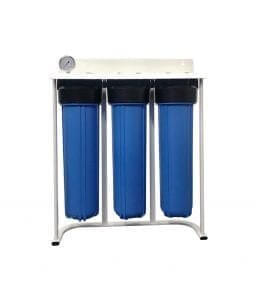
Aqua Care Triple Stage
(N$ 5 175.00 VAT EX)
Aqua Care Triple Stage
DESCRIPTION
Triple Stage Whole House System
The Whole House System is designed with a three-stage water filtration system that consists of Polypropylene Sediment Removal filters and A Activated Carbon Block filter, and an ultraviolet disinfection system.
The following are the filtration stages of a Whole House System
First & Third Stage Filtration (Polypropylene Sediment removal Filters)
This sediment filter is for domestic water filtration purposes. It is designed to filter out sediments such as rust, mud, and dust particles from the municipality and rainwater.
The polypropylene sediment removal filter cartridge is constructed by three layers three of heat melting polypropylene. Compared to monolayer, the application life of PP melt blown filter cartridge with three layers is much longer. Therefore, the maintenance of the filters can be cut down a lot Using the right heating way for PP fiber, it can reduce the filtering resistance a lot and enlarge the water flow much The uniform space of fiber can achieve an excellent filtering effect As the filter cartridge is only made from polypropylene, the resistance to chemical reagents for both organic solvent and the inorganic solvent is all good.
Most water purifiers use a polypropylene sediment removal filter cartridge for the first stage of the filter element. The first stage of the filter element is not only directly affects the water quality but also affects the subsequent secondary or tertiary filtration effect and the life of the filter element. Therefore, the quality of PP filter is especially important for water purifiers.
If the RO system is not equipped with a polypropylene sediment removal filter, the raw water directly enters the RO membrane. Excessive particles, precipitates, microorganisms, and bacterial viruses that are not treated will block in the RO membrane, and the life of the RO membrane will be shortened, which will also affect the quality of the final water.
FUNCTION:
The function of the polypropylene sediment removal filter cartridge filter is to separate substances or particles from the liquid. The cartridge filter is a medium to filtrate substance that flows with liquid. Cartridge filter in this project focuses on a water filtration system that usually used at houses and small-scale industries. The volume flow rate relates to the pressure of the water that flows through the pipe system. Cartridge filter function as a media that reduced pressure from the water flow and call pressure drop. Sediment sand particles function as particles that flow with the water and will filtrate with a cartridge filter. Sediment sand makes contact on the surface of the cartridge filter depend on the volume flow rate of water.
The cartridge will be clogged because of sediment sand clog on the surface of the cartridge filter when tried to enter the cartridge filter. This situation makes the filtration system has different pressure on the entrance and the exit of the cartridge housing. Different pressure call pressure drop represents the pressure drop of the cartridge. The pressure drop can relate to the volume flow rate and determining the life span and maximum condition of the cartridge filter. The maximum clogging condition happens because the pressure of the cartridge filter does not increase anymore and the cartridge filter has fully clogged with sediment sand.
Second Stage Filtration (Activated Carbon Block Filter)
CTO Carbon block filters are made from activated carbon and its specific function is the chemical adsorption of impurities and contaminants in drinking water.
Activated carbon block filter is an ideal medium for treating contaminants in water, offering a large surface area for the adsorption of dissolved matter. Building upon this, the solid carbon block enhances the medium by preventing channeling, increasing surface contact time, and enabling custom pore formulation for mechanical filtration. Carbon Blocks are one of the most effective and widely used technologies in the Point Of Use (POU) drinking water treatment industry.
This comprehensive guide addresses key considerations a buyer should evaluate when designing a carbon block filter and selecting a supplier, including:
– Activated Carbon for Water Filtration
– Why Carbon Block is the Better Choice
– How Carbon Blocks Filter Water
– Compressed vs. Extruded Carbon Block Manufacturing Processes
– Carbon Block vs. Other Filtration Technologies
– Design Parameters
– Performance Indication Device
– Advantages of a Custom Filter
– Choosing a Custom Carbon Block Supplier
– Your Custom Carbon Block Specifications
Function Of An Activated Carbon Block Filter Cartridge:
Carbon block filters are made from activated carbon. Its function is to adsorb chemical impurities and contaminants in drinking water. Carbon filters are widely used to remove chlorine, taste, odor, and color.
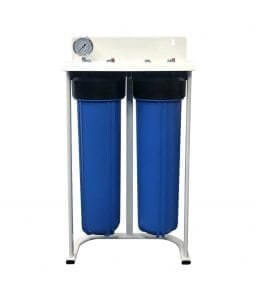
Aqua Care Double Stage
(N$ 3 450.00 VAT EX)
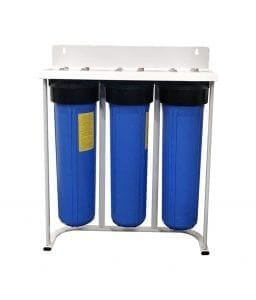
Toppurror Whole House System
(N$ 5 747.70 VAT EX)
Toppurror Whole House System
DESCRIPTION
Triple Stage Whole House System
The Whole House System is designed with a three-stage water filtration system that consists of Polypropylene Sediment Removal filters and A Activated Carbon Block filter, and an ultraviolet disinfection system.
The following are the filtration stages of a Whole House System
First & Third Stage Filtration (Polypropylene Sediment removal Filters)
This sediment filter is for domestic water filtration purposes. It is designed to filter out sediments such as rust, mud, and dust particles from the municipality and rainwater.
The polypropylene sediment removal filter cartridge is constructed by three layers three of heat melting polypropylene. Compared to monolayer, the application life of PP melt blown filter cartridge with three layers is much longer. Therefore, the maintenance of the filters can be cut down a lot Using the right heating way for PP fiber, it can reduce the filtering resistance a lot and enlarge the water flow much The uniform space of fiber can achieve an excellent filtering effect As the filter cartridge is only made from polypropylene, the resistance to chemical reagents for both organic solvent and the inorganic solvent is all good.
Most water purifiers use a polypropylene sediment removal filter cartridge for the first stage of the filter element. The first stage of the filter element is not only directly affects the water quality but also affects the subsequent secondary or tertiary filtration effect and the life of the filter element. Therefore, the quality of PP filter is especially important for water purifiers.
If the RO system is not equipped with a polypropylene sediment removal filter, the raw water directly enters the RO membrane. Excessive particles, precipitates, microorganisms, and bacterial viruses that are not treated will block in the RO membrane, and the life of the RO membrane will be shortened, which will also affect the quality of the final water.
FUNCTION:
The function of the polypropylene sediment removal filter cartridge filter is to separate substances or particles from the liquid. The cartridge filter is a medium to filtrate substance that flows with liquid. Cartridge filter in this project focuses on a water filtration system that usually used at houses and small-scale industries. The volume flow rate relates to the pressure of the water that flows through the pipe system. Cartridge filter function as a media that reduced pressure from the water flow and call pressure drop. Sediment sand particles function as particles that flow with the water and will filtrate with a cartridge filter. Sediment sand makes contact on the surface of the cartridge filter depend on the volume flow rate of water.
The cartridge will be clogged because of sediment sand clog on the surface of the cartridge filter when tried to enter the cartridge filter. This situation makes the filtration system has different pressure on the entrance and the exit of the cartridge housing. Different pressure call pressure drop represents the pressure drop of the cartridge. The pressure drop can relate to the volume flow rate and determining the life span and maximum condition of the cartridge filter. The maximum clogging condition happens because the pressure of the cartridge filter does not increase anymore and the cartridge filter has fully clogged with sediment sand.
Second Stage Filtration (Activated Carbon Block Filter)
CTO Carbon block filters are made from activated carbon and its specific function is the chemical adsorption of impurities and contaminants in drinking water.
Activated carbon block filter is an ideal medium for treating contaminants in water, offering a large surface area for the adsorption of dissolved matter. Building upon this, the solid carbon block enhances the medium by preventing channeling, increasing surface contact time, and enabling custom pore formulation for mechanical filtration. Carbon Blocks are one of the most effective and widely used technologies in the Point Of Use (POU) drinking water treatment industry.
This comprehensive guide addresses key considerations a buyer should evaluate when designing a carbon block filter and selecting a supplier, including:
– Activated Carbon for Water Filtration
– Why Carbon Block is the Better Choice
– How Carbon Blocks Filter Water
– Compressed vs. Extruded Carbon Block Manufacturing Processes
– Carbon Block vs. Other Filtration Technologies
– Design Parameters
– Performance Indication Device
– Advantages of a Custom Filter
– Choosing a Custom Carbon Block Supplier
– Your Custom Carbon Block Specifications
Function Of An Activated Carbon Block Filter Cartridge:
Carbon block filters are made from activated carbon. Its function is to adsorb chemical impurities and contaminants in drinking water. Carbon filters are widely used to remove chlorine, taste, odor, and color.
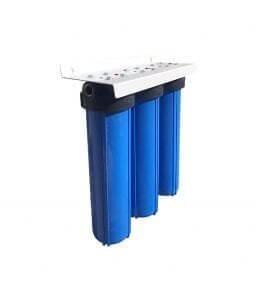
Whole House System (Bracket)
(N$ 2 875.00 VAT EX)
Toppurror Whole House System
DESCRIPTION
Triple Stage Whole House System
The Whole House System is designed with a three-stage water filtration system that consists of Polypropylene Sediment Removal filters and A Activated Carbon Block filter, and an ultraviolet disinfection system.
The following are the filtration stages of a Whole House System
First & Third Stage Filtration (Polypropylene Sediment removal Filters)
This sediment filter is for domestic water filtration purposes. It is designed to filter out sediments such as rust, mud, and dust particles from the municipality and rainwater.
The polypropylene sediment removal filter cartridge is constructed by three layers three of heat melting polypropylene. Compared to monolayer, the application life of PP melt blown filter cartridge with three layers is much longer. Therefore, the maintenance of the filters can be cut down a lot Using the right heating way for PP fiber, it can reduce the filtering resistance a lot and enlarge the water flow much The uniform space of fiber can achieve an excellent filtering effect As the filter cartridge is only made from polypropylene, the resistance to chemical reagents for both organic solvent and the inorganic solvent is all good.
Most water purifiers use a polypropylene sediment removal filter cartridge for the first stage of the filter element. The first stage of the filter element is not only directly affects the water quality but also affects the subsequent secondary or tertiary filtration effect and the life of the filter element. Therefore, the quality of PP filter is especially important for water purifiers.
If the RO system is not equipped with a polypropylene sediment removal filter, the raw water directly enters the RO membrane. Excessive particles, precipitates, microorganisms, and bacterial viruses that are not treated will block in the RO membrane, and the life of the RO membrane will be shortened, which will also affect the quality of the final water.
FUNCTION:
The function of the polypropylene sediment removal filter cartridge filter is to separate substances or particles from the liquid. The cartridge filter is a medium to filtrate substance that flows with liquid. Cartridge filter in this project focuses on a water filtration system that usually used at houses and small-scale industries. The volume flow rate relates to the pressure of the water that flows through the pipe system. Cartridge filter function as a media that reduced pressure from the water flow and call pressure drop. Sediment sand particles function as particles that flow with the water and will filtrate with a cartridge filter. Sediment sand makes contact on the surface of the cartridge filter depend on the volume flow rate of water.
The cartridge will be clogged because of sediment sand clog on the surface of the cartridge filter when tried to enter the cartridge filter. This situation makes the filtration system has different pressure on the entrance and the exit of the cartridge housing. Different pressure call pressure drop represents the pressure drop of the cartridge. The pressure drop can relate to the volume flow rate and determining the life span and maximum condition of the cartridge filter. The maximum clogging condition happens because the pressure of the cartridge filter does not increase anymore and the cartridge filter has fully clogged with sediment sand.
Second Stage Filtration (Activated Carbon Block Filter)
CTO Carbon block filters are made from activated carbon and its specific function is the chemical adsorption of impurities and contaminants in drinking water.
Activated carbon block filter is an ideal medium for treating contaminants in water, offering a large surface area for the adsorption of dissolved matter. Building upon this, the solid carbon block enhances the medium by preventing channeling, increasing surface contact time, and enabling custom pore formulation for mechanical filtration. Carbon Blocks are one of the most effective and widely used technologies in the Point Of Use (POU) drinking water treatment industry.
This comprehensive guide addresses key considerations a buyer should evaluate when designing a carbon block filter and selecting a supplier, including:
– Activated Carbon for Water Filtration
– Why Carbon Block is the Better Choice
– How Carbon Blocks Filter Water
– Compressed vs. Extruded Carbon Block Manufacturing Processes
– Carbon Block vs. Other Filtration Technologies
– Design Parameters
– Performance Indication Device
– Advantages of a Custom Filter
– Choosing a Custom Carbon Block Supplier
– Your Custom Carbon Block Specifications
Function Of An Activated Carbon Block Filter Cartridge:
Carbon block filters are made from activated carbon. Its function is to adsorb chemical impurities and contaminants in drinking water. Carbon filters are widely used to remove chlorine, taste, odor, and color.


